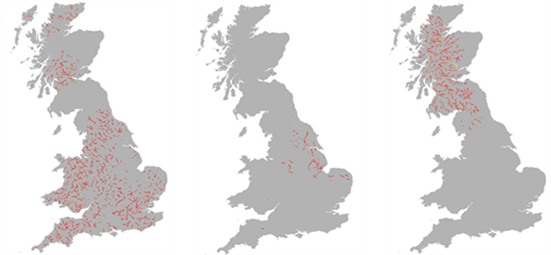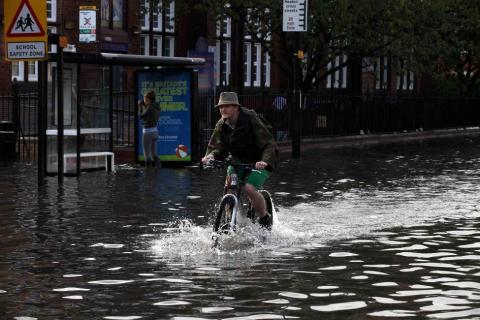Paul Sayers, of Sayers and Partners, project lead for UKCR project AquaCAT, on climate change driven changes to UK flood risk
Spatially coherent (widespread) flood events can cause significant damage and disruption in the UK. Catastrophe (CAT) Modelling was developed in the late 1980s to capture the spatial correlation of such events for use in insurance and financial risk management industries. The approaches identify event ‘footprints’ (i.e. the spatial area impacted) to demonstrate how an extreme event impacts different locations at a similar time (e.g. in a 48h window). Such approaches typically focus on present day risks. When adjustments are made for climate change these tend to be based upon local site allowances (e.g. a given percentage change in the increase in river flow).
For the first time, this research is exploring how climate change may influence the spatial structure of widespread events and how any change may influence future risks and our approach to managing them. To do so we are bringing together climate and CAT modelling approaches within an innovative and efficient event-based climate change risk assessment framework (AquaCAT) that overcomes the well-rehearsed short-comings of Catastrophe Models (in terms of supporting a climate and adaptation perspective) and the limitations of conventional climate risk and adaptation approaches (in terms of their inability to readily express spatially coherent risks).
Our approach uses spatially coherent projections of weather and climate over the UK from the UKCP18 project to determine spatially coherent changes in river flows (using the CEH Grid-2-Grid model). This enables us to extract climate model driven widespread flood footprints for the present day and future epochs through to the end of the 21st century. However, the sizeable number of events directly simulated is still not large enough to look at the statistics of very rare events. To overcome this we are comparing two techniques to generate a large synthetic event set: The first approaches applies a statistical model (Heffernan and Tawn) to describe how correlated extreme events are at different places, and in the second we have developed an Empirical Copula approach, which uses the model simulations of flooding directly to maintain realistic overall patterns. Insights from this analysis will help us understand how the shape and spatial extent of extreme flood events might change in the future; for example if projected-future flood events will occur over a wider contiguous area, in more separate places simultaneously, or whether events floods will have similar footprints as they do now.

Three examples of possible widespread flood events that may occur (given the climate in the 2080s); red shows area where the flood flows are rarer than a 1 in 5 year return period.
Having created enough physically plausible events, probabilistic climate projections (from across all Representative Concentration Pathways – RCPs) are used to scale the extreme flows at each location. This enables bias correction and hydrological uncertainties to be incorporated while maintaining the spatial coherence. The resulting events, are then used within the Future Flood Explorer to develop event-based flood risk (taking account of the influence of flood defences) and derive future changes in Expected Annual Damages that take account of the changing spatial structure of future events.
The outputs provide added-value to the UKCP datasets and help incorporate changes in spatial coherence into the assessment of future flood risk and the identification of event losses. This capability is increasingly required by insurance and financial sector ‘stress tests’ (that now include physical climate risks)[1] as well as within exploratory models capable of supporting longer-term adaptation planning for flood management.
For further information contact Paul Sayers, paul.sayers@sayersandpartners.co.uk
This research is funded as part of the SPF UKCR programme and managed through the Met Office Work Package From Climate Hazard to Climate Risk.
[1] https://www.bankofengland.co.uk/stress-testing

